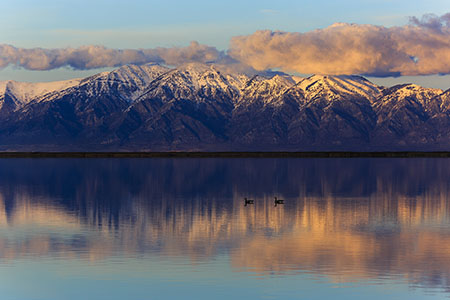
In 1991, the Utah Legislature passed the Bear River Development Act, [Utah Code 73-26], which authorizes and directs the Division of Water Resources to “…develop the surface waters of the Bear River and its tributaries through the planning and construction of reservoirs and associated facilities…” When this legislation was passed, the projected need for water from the Bear River Development (BRD) was 2015. Thanks primarily to conservation efforts, new technology (secondary meters), optimization and efficiency projects, the initial projected need is now 2050 or later.
Planning and studies for the development or storage of the Bear River have been ongoing for several decades. The Division most recently completed a Feasibility Study in 2019. The study includes conceptual level planning for a potential BRD system (at full development) that would include reservoirs, pipelines, pump stations and other facilities. Multiple options of reservoirs and pipeline corridors have been studied and cost estimates have been updated.
Although the projected need for this water supply is 2050 or later, the Division of Water Resources is preserving potential corridors for a large-diameter pipeline through the early acquisition of undeveloped land from willing sellers.
It should be noted that while the initial need for this water supply is 2050+, the need for full development of 220,000 acre-feet is projected to be decades beyond the initial need.
2019 Bear River Development Feasibility Study (four files)
Bear River Development Report Executive Summary – Final
Bear River Development Report Volume I – Report
Bear River Development Report Volume II – Figures
Bear River Development Report Volume III – Appendix
NOTE: Hard copies of Volumes I and II are available to view at the following locations:
Division of Water Resources, 1594 W. North Temple, Suite 310, Salt Lake City
Davis County Library, 133 S. Main St., Farmington
Brigham City Library, 26 E. Forest St., Brigham City
Logan Library, 255 Main St., Logan
View the Press Release
BRD Fact Sheet
Who will the project benefit?
The Bear River Development is designed to provide additional water supplies for northern Utah residents.
When will it be needed?
Original projections estimated the water would be needed in 2015. However, current estimates place the demand of the project to be 2050 or later. This could change based on conservation progress and population growth. Although the water is not needed for many years, the division has begun corridor preservation for a large-diameter pipeline through Box Elder County. As development has increased, the division has seen the need to preserve a corridor to reduce future impacts to the surrounding communities. The division is working with willing sellers on the early acquisition of properties to preserve corridors.
How will it impact Great Salt Lake’s elevation?
The BRD system is expected to deliver 220,000 acre-feet annually. However, not all the water is expected to be depleted from the watershed. Much is expected to return to the watershed in the form of “return flows.” At full development, an estimated 85,600 acre-feet would be fully depleted from the watershed. Current modeling indicates this amount of depletion from the Great Salt Lake watershed would reduce the lake level by an average of about 8.5 inches and as much as 14 inches according to a White Paper published in 2016 by Utah State University, Water Resources, Salt Lake Community College, and the Utah Division of Wildlife Resources.
How much will it cost?
Cost estimates were produced for 13 scenarios of reservoir combinations. These estimates range between $1.5 and $2.8 Billion. An updated cost estimate will be prepared when the environmental studies are complete and alignment and design are determined.
Four water districts will deliver the water
As outlined in the Bear River Development Act, the BRD system, at full development, would deliver 220,000 acre-feet. Four water districts will deliver the water in the following amounts:
• Bear River Water Conservancy District – 60,000 acre-feet
• Cache Water District – 60,000 acre-feet
• Jordan Valley Water Conservancy District – 50,000 acre-feet
• Weber Basin Water Conservancy District – 50,000 acre-feet
Additional Resources
Vol I – Draft Bear River Pipeline Concept Report (2014): Study of potential alignments for the Bear River Pipeline. The study also includes a preliminary analysis of potential reservoir sites for the Bear River Development.
Vol II – Draft Bear River Pipeline Concept Report (2014): Volume 2 contains the figures, drawings, tables and figures that accompany the study summarized in Volume 1 above.
Impacts of Water Development of Great Salt Lake & the Wasatch Front (2016): A white paper regarding the impacts of water development on the Great Salt Lake.
For more information, contact Bear River Development Manager Marisa Egbert at marisaegbert@utah.gov or 801-403-8077.
